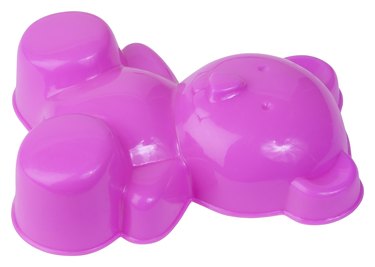Things You'll Need
Tape measure
2-part liquid rubber compound
2 plastic cups
Paste pigment
Wooden stir sticks

Liquid rubber, used primarily for prototyping applications, can be poured over a model and allowed to harden without it adhering to the model surface. The hardened rubber shell, once removed, carries the surface details of the modeled object. With the details intact, you can replicate the object in its exact size down to the surface texture, depending upon the casting material used. Liquid rubber comes in a variety of compounds, based on silicone or polyurethane. Each compound creates a liquid of a specific viscosity for pouring or brushing over a surface, and each has a specific tear strength for toughness with harder casting materials. No matter what the liquid rubber compound is made of, the liquid creation remains largely the same.
Step 1
Measure the area that you're filling with the liquid rubber, for example, a box with a model inside. Use a tape measure to find length, width and height measurements. Multiply the length, width and height to get the volume of the fill space. For example, a 5-inch cube would be 5-inches high by 5-inches wide by 5-inch deep, or 125-cubic inches in volume.
Video of the Day
Step 2
Measure the object that you're modeling using the same measurements you used to get the object volume. A 4-inch cube as a model would be 4-by-4-by-4 inches, equaling 64-cubic inches in volume.
Step 3
Subtract the model volume from the area volume to get the total amount of liquid rubber needed to mix for your project. Adjust the amount up 10 percent for a small safety measure. A 125-cubic inch box with a 64-cubic inch model would require 61-cubic inches in liquid rubber volume, plus 6 inches safety margin, or 67 cubic inches rubber total. Check the coverage information provided by the rubber manufacturer to determine the amount of liquid rubber needed to cover the volume.
Step 4
Measure out the suggested amount of liquid rubber for the coverage needed, and pour the necessary amounts of each compound by ratio into separate cups. The two parts of the rubber mix are labeled "A" and "B." The ratio you should use is listed in the manufacturer instructions.
Step 5
Mix each component for three minutes until any color streaking is gone from the materials. To tint the rubber, add the paste pigment to the cup containing the largest amount of component.
Step 6
Pour component "B" into Component "A" and mix thoroughly. Once combined, the rubber begins to cure immediately, and each liquid rubber compound containing a specific pot-life. The pot-life is the length of time that the rubber has enough viscosity to be poured or brushed into place. After the pot-life ends, you can no longer use the rubber in its liquid form.
Tip
Use liquid rubber to cast models as well as for mold-making by pouring the rubber into an already created mold.
Video of the Day